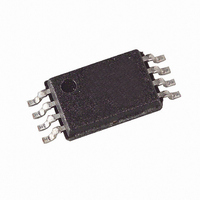AT24C16B-TH-B Atmel, AT24C16B-TH-B Datasheet - Page 9

AT24C16B-TH-B
Manufacturer Part Number
AT24C16B-TH-B
Description
IC EEPROM 16KBIT 1MHZ 8TSSOP
Manufacturer
Atmel
Datasheet
1.AT24C16BY6-YH-T.pdf
(27 pages)
Specifications of AT24C16B-TH-B
Format - Memory
EEPROMs - Serial
Memory Type
EEPROM
Memory Size
16K (2K x 8)
Speed
400kHz, 1MHz
Interface
I²C, 2-Wire Serial
Voltage - Supply
1.8 V ~ 5.5 V
Operating Temperature
-40°C ~ 85°C
Package / Case
8-TSSOP
Organization
256 K x 8
Interface Type
2-Wire
Maximum Clock Frequency
0.4 MHz
Access Time
900 ns
Supply Voltage (max)
5.5 V
Supply Voltage (min)
1.8 V
Maximum Operating Current
3 mA
Maximum Operating Temperature
+ 85 C
Mounting Style
SMD/SMT
Minimum Operating Temperature
- 40 C
Operating Supply Voltage
1.8 V, 3.6 V
Lead Free Status / RoHS Status
Lead free / RoHS Compliant
8. Device Addressing
9. Write Operations
5175E–SEEPR–3/09
The 16K EEPROM device requires an 8-bit device address word following a start condition to
enable the chip for a read or write operation (refer to
The device address word consists of a mandatory one, zero sequence for the first four most sig-
nificant bits as shown. This is common to all the EEPROM devices.
The next 3 bits used for memory page addressing and are the most significant bits of the data
word address which follows.
The eighth bit of the device address is the read/write operation select bit. A read operation is ini-
tiated if this bit is high and a write operation is initiated if this bit is low.
Upon a compare of the device address, the EEPROM will output a zero. If a compare is not
made, the chip will return to a standby state.
BYTE WRITE: A write operation requires an 8-bit data word address following the device
address word and acknowledgment. Upon receipt of this address, the EEPROM will again
respond with a zero and then clock in the first 8-bit data word. Following receipt of the 8-bit data
word, the EEPROM will output a zero and the addressing device, such as a microcontroller,
must terminate the write sequence with a stop condition. At this time the EEPROM enters an
internally timed write cycle, t
write cycle and the EEPROM will not respond until the write is complete (see
page
PAGE WRITE: The 16K EEPROM is capable of an 16-byte page write.
A page write is initiated the same as a byte write, but the microcontroller does not send a stop
condition after the first data word is clocked in. Instead, after the EEPROM acknowledges
receipt of the first data word, the microcontroller can transmit up to fifteen data words. The
EEPROM will respond with a zero after each data word received. The microcontroller must ter-
minate the page write sequence with a stop condition (see
The data word address lower three bits are internally incremented following the receipt of each
data word. The higher data word address bits are not incremented, retaining the memory page
row location. When the word address, internally generated, reaches the page boundary, the fol-
lowing byte is placed at the beginning of the same page. If more than sixteen data words are
transmitted to the EEPROM, the data word address will “roll over” and previous data will be
overwritten.
ACKNOWLEDGE POLLING: Once the internally timed write cycle has started and the
EEPROM inputs are disabled, acknowledge polling can be initiated. This involves sending a
start condition followed by the device address word. The read/write bit is representative of the
operation desired. Only if the internal write cycle has completed will the EEPROM respond with
a zero allowing the read or write sequence to continue.
11).
WR
, to the nonvolatile memory. All inputs are disabled during this
Figure
Figure 10-3 on page
10-1).
11).
Figure 10-2 on
9














